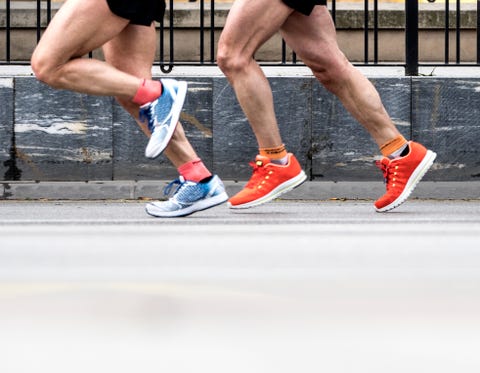There’s running. And then there’s sprinting. And no, they’re not the same thing.
When you think “running,” you very likely think of running a 5K or 10K, or a few miles at the start of your morning. It’s about putting one foot in front of the other for several miles, a workout that’ll leave you dripping in sweat and leave your lower body thrashed.
Sprinting, however, in its purest sense, is about getting to your top speed, something you can only hold for a matter of seconds. It’s about truly accelerating your body and owning every phase of your stride, about going all-out. It’s not easy, either, and just a few seconds of true sprint can leave you gassed.
But learning this art can make all your distance running workouts even faster and better. You’ll see yourself setting new personal records in those 5Ks and 10Ks, and you’ll have a new option for a quick calorie-burning session, too.
Sprinting pushes your body to light up different muscle fibers, activating fast-twitch fibers in addition to the traditional slow-twitch fibers that drive endurance activity. One March 2018 study found that just six sessions of sprint training could improve your running performance, even if you’ve been running for several years already.
I’ve trained frequently to work on my sprint technique over the years, most recently this past January, when I worked out weekly with Nike trainer Jess Woods, focusing on getting faster. It’s the kind of training that impacts all my running workouts, equipping me to sprint better, and also leaving my legs more explosive and well-conditioned for long-distance work, too.
You get it now: Learning to sprint can make you a better all-around runner. But unlike the basics of running, sprinting isn’t natural, especially not if you’ve spent your life doing a desk job. To actively run fast, you have to do more than run; you have to think about perfecting your running mechanics.
How To Hone a Sprinter’s Stride
View this post on Instagram
A post shared by Eb Samuel (@ebenezersamuel23) on
A sprint stride isn’t just one foot in front of the other, like your normal running stride. It’s a far more nuanced motion than that, one designed to get all your momentum going in one direction as quickly as possible, with as little wasted motion as possible. To build that stride, you need to make adjustments to the casual way you might take a normal five-mile morning run. These drills, which I learned over the years and reinforced with Woods in January, can help get you there.
Involve Your Arms
Distance runners don’t always move their arms much when they run. There’s a reason for that: Maintaining a quiet upper body can help conserve energy.
But a sprint isn’t about energy conservation; it’s about getting where you need to as quickly as possible. And involving your arms can help you build speed. So learn to pump your arms hard and aggressively when you aim to pick up speed by sprinting.

ROBERTO PERIGetty Images
Doing this will fuel a more aggressive leg stride, too, because your upper and lower body are more interconnected than you may think. The key is how you pump your arms. Don’t run with your arms crossing your body; do everything to keep your each arm pumping straight forward in the direction you’re trying to go. And try to pump them quickly.
One way to work on this (and yes, it does take work): Sit on the ground, legs straight out in front of you, core tight. Without moving your legs, pump your arms as quickly and powerfully as possible, so hard that your butt starts to come off the ground and you almost begin to move forward. Do this for 30 seconds on, 30 seconds off, for 5 minutes every few days to reinforce arm-sprinting efficiency.
Attack the Ground
If you’re a quiet runner who tends to float off the ground, you’re going to want to change that to really build speed. Sprinting requires you to attack the ground with every step.
First off, you want to make sure every step counts. When you’re running a long distance, you can waste a step here or there, maybe not go max-effort in a few moments. But when you sprint, you want to pound the ground with your foot at every moment. As Woods would tell me, you want to “be loud and noisy.” Try to hit the ground hard on every step.
That’s not just for dramatic effect. Your calf functions much like a spring when you sprint, absorbing then exploding back with that same energy in something called the “stretch-shortening cycle.” If you don’t pound the ground, you aren’t loading the spring quite as much. So run loud when you want to sprint, really attacking the ground. You can work on this during your basic sprint drills. If you’ve ever done high-knees, think about doing those high-knees but being impactful with each stride.
Drive Your Knees High
Knee drive is critical when you sprint. The higher you can drive your knee relative to your hips, without rolling your pelvis completely forward, the longer you’ll be able to make each stride. And 10 quick, long steps will beat 10 quick steps that simply don’t cover as much ground.
To train that knee drive work on high-knee drills. Aim to do 3 30-second bursts of high knees before every sprint or running workout.
Learn to Dorsiflex
As you work on your knee drive, also think about dorsiflexing the foot you’re raising. What does it mean to dorsiflex? It means you’re using your shin muscles to flex your foot upwards. When this happens, it’ll help drive your front calf forwards more aggressively (and help you attack the ground, too.
Focus on Core
Your core is critical to your ability to sprint. A strong core will let your arm pumps drive your legs more naturally, and it’ll also put you in a better physical position to sprint. You want to form a straight line from head through to toe of your straightened leg on every stride, creating a strong position from which to drive. That will happen best with a strong core.
There are a host of exercises you can do for this, but start with moves like the plank. You can study up on the plank right here.
Master the plank, and you can also play with more advanced core moves, like this dragon flag move.
2 Quick Sprint Workouts

Jose A. Bernat BaceteGetty Images
Hone your sprinting technique, and you’ll ready your body for another kind of running workout: The sprint workout. Sprint workouts have you running all-out for just a few seconds, then dialing it back to recover. They’re also among the truest high-intensity interval training there is, meaning they’ll incinerate plenty of calories as they build muscle, heart capacity, and endurance, too.
Give these two sample sprint workouts a try:
The Football Field Frenzy
Warm up with a quick 10-minute jog. Then set up on one side of the football field. Run 10 yards as hard as you can, focusing on keeping all your momentum going forward. Walk back to the starting line and repeat. Then run 20 yards. Walk back to the starting line and repeat. Repeat this process all the way up to 50 yards, then rest for 4 minutes. Do this twice.
Timed Road Race
You can do this one anywhere you want to run. Jog for 10 minutes along your favorite running path to warm up. Instantly start running as hard as you can for 20 seconds, then back off to a 1-minute jog. Repeat this process 4 times, then jog for 5 minutes. Repeat the 20-seconds-hard, 1-minute-of-jogging pattern one more time.
Source: Read Full Article
